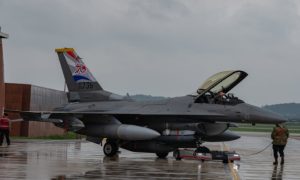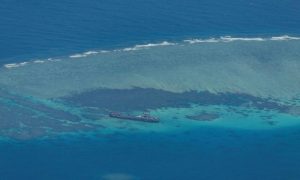Russia has begun to mobilize military reinforcements to send into Ukraine as its combat losses continue to grow, the Pentagon said Friday, citing its latest intelligence assessments.
“We now have indications that they are drawing on forces from Georgia,” said a senior U.S. defense official, speaking on the condition of anonymity under ground rules set by the Biden administration. “Russian troops that are based in Georgia. We don’t have an exact number.”
Thousands of Russian troops are stationed at military outposts from Georgia to Syria to Tajikistan, many of them assigned to motorized rifle brigades that experts consider combat-capable and ready to deploy immediately.
Those forces have become the centerpiece of what the Pentagon believes is the Kremlin’s plan to keep its ground offensive going, as Russian commanders in Ukraine sustain heavy casualties. According to the Pentagon, Russia now has between 85 and 90 percent of its “combat power” remaining after meeting a ferocious resistance in and around cities throughout the country. The invading force numbered about 150,000 personnel.
NATO officials estimated earlier this week that as many as 15,000 Russian troops have been killed in the war, which began four weeks ago. Russia has offered a far lower figure, reporting Friday that only 1,351 of its servicemen had died in the fighting.Russia’s war for Ukraine could be headed toward stalemate
While reinforcements may bring Russian forces in Ukraine some temporary relief, they are unlikely to change the war’s course, according to military experts who focus on the region. They note that Russia cannot redeploy foreign-based troops in significant numbers without creating vulnerabilities in other hot spots, as its military probably does not have enough skilled personnel in the pipeline to keep those stations adequately manned and fuel an influx capable of overwhelming local resistance.
“I’m not sure that anything that the Russian military will do will change the balance; it’s more about patching up gaps,” said Dmitry Gorenburg, a Russian military expert with CNA, a Washington think tank. “They’re going to be brought in as fresh bodies, primarily, to replenish the losses. … Folks who are suggesting they’re bringing in everybody they can for one big push to break Ukrainian resistance, I don’t see that as possible now.”
The Russian military has several contingents stationed abroad, but those considered most ripe for tapping reinforcements are located in Georgia’s separatist republics of South Ossetia and Abkhazia, and in Armenia, Syria and Tajikistan.
Tajikistan, which hosts a Russian division outside of its capital, Dushanbe, is the largest outpost, and chiefly occupied with monitoring and managing threats emanating from Afghanistan.
There are a few thousand Russian forces based in each of the Georgian breakaway republics, which have depended on Russian patronage since the 2008 Russo-Georgian war. A similar number are based in Armenia, where Russia’s footprint has grown since Moscow began deploying peacekeepers to manage the aftermath of the recent war in Nagorno Karabakh.
It is unclear how many Russian troops are operating in Syria, where they joined the civil war in 2015 on the side of president Bashar al-Assad’s army.
Troops stationed in these countries are predominantly contract soldiers — members of Russia’s professional volunteer force — not the lesser-trained conscripts who compose more than a quarter of Russia’s total military force. That gives them some potential advantages, experts note.
“If they are substituting the contract soldiers for the conscripts, who have been drafted and aren’t happy and aren’t as well trained, then that could be helpful. They’re probably better trained as well, and their morale will certainly be higher than the conscripts that came in thinking they were going to liberate the Donbas and instead found themselves mired around Kyiv,” said Jim Townsend, the deputy assistant secretary of defense for Europe and NATO during the Obama administration.

Headgear worn by a Russian tank operator lies on the ground next to a destroyed tank in Irpin, on the outskirts of Kyiv.
Townsend was referring to violent clashes within the separatist region in eastern Ukraine, where Russian forces have begun to concentrate their efforts, and around the capital, where stiff resistance has compelled advancing units to form defensive positions.
“But just because they’re new doesn’t mean they’re better and just because they’re new doesn’t mean they’re the kinds of troops that are needed for the battlefield in Ukraine,” he added. “If they bring in infantry when they need to bring in logisticians, that’s not going to help.”Russia focusing fight in Donbas in possible strategy to save face
Russia’s foreign garrisons do not boast particularly elite personnel, experts say, and its efforts to modernize such outposts, they add, have lagged behind other parts of the force.
“These units aren’t really that unique and, for the most part, they are not as well equipped as some of the best Russian units; only last year did they start to reequip the ones in Tajikistan,” said Rob Lee, a Russian military expert with the Foreign Policy Research Institute. But, he noted, Moscow is not in much of a position to be picky, given that it has already committed a majority of its battalion tactical groups to its operations in Ukraine.
“You’re talking up to a third or more of the actual combat troops deployed to Ukraine are casualties, which is an insane number,” Lee continued. “It’s not surprising that if they have to pull from anywhere, it’s going to include these other bases … it’s another indication that they’re just having issues with their manpower.”
But diverting personnel to Ukraine could create some risk for Russia in the areas they are drawn from, some experts say. In Georgia, for instance, there have been selective calls among the citizenry to take advantage of Russia’s preoccupation in Ukraine by trying to reclaim South Ossetia and Abkhazia. Though the likelihood such an operation would be successful is considered remote, it is reason for Moscow to be wary of how far it draws down its forces there.
Around Armenia, there is danger of a regional flare-up should Russia pull away too many troops, especially those who have been deployed as a peacekeeping force in Nagorno Karabakh, an Armenian-populated enclave that declared a contested independence from Azerbaijan during the dissolution of the Soviet Union, and was the site of a bloody war in 2020, as Azerbaijan reclaimed parts of the territory. Tensions with Azerbaijan have spiked again in recent weeks, sparking new concerns war could resume.
Some reports from the region also suggest that Armenia and Turkey are inching closer to normalized relations — a shift that Russia may see as reason to sustain its geopolitical “levers” in the region, Gorenburg pointed out.
In Syria, meanwhile, pervasive instability poses a potential complication to drawing on forces to backfill losses in Ukraine. Syria has been an important foothold for Russian force projection in the Middle East, and Moscow has maintained a contingent of forces and continued to invest resources there, even after the worst of the civil war died down. That trend appears to be continuing, despite the intensity of hostilities in Ukraine: Russia’s military positioned warplanes in Syria for naval drills earlier this year.
“The problem,” Lee said, “is they need troops there, they continue to patrol in northern Syria, and they also patrol in northeastern Syria’s border with Turkey. So they can’t pull too many guys away from there.”
In Tajikistan, the threat from Afghanistan is thought to be less critical now than they were during the height of the Taliban’s resurgence and the American evacuation. Russia has invested in its Tajik base more than most other outposts, sending new equipment in recent months and staging military drills there over the summer.
Beyond Georgia, the Pentagon has yet to assess with any certainty from where Russia may pull additional reinforcements — and when any such troops might start joining those in Ukraine. Russia is already drawing on paramilitary forces, including mercenary organizations like the Wagner Group, and Chechen fighters loyal to Ramzan Kadyrov, an ally of Russian President Vladimir Putin and the region’s leader.U.S. blacklists strongman of Chechnya for human rights abuses
Boasts by Putin and his defense minister, Sergei Shoigu, that thousands of Middle Eastern “volunteers” would join the Russian invasion in Ukraine appear not to have come to fruition. On Friday, Russia’s Ministry of Defense claimed that 23,000 volunteers from 37 unidentified countries had expressed their willingness to fight but that separatist leaders in Ukraine’s Donetsk and Luhansk regions refused the help. Earlier this month, only four countries — Belarus, Eritrea, North Korea and Syria — joined Russia in voting against a U.N. General Assembly condemnation of the Ukraine invasion, while 38 countries abstained.
That leaves Russian reinforcements stationed abroad as the Kremlin’s best and most likely option for shoring up its growing losses. But these will provide Putin with only a “short-to-medium-term solution,” experts say.
“It’s not a game changer. A game changer is coming in and wiping out the Ukraine air force. A game changer is coming in and using chemical warfare,” Townsend said. More troops, he added, are just “another card [Putin] can play before he turns to chemical weapons.”
Russia’s vast arsenal of chemical, biological and tactical nuclear weapons has fueled speculation about what Putin may do if he feels he is running out of options in Ukraine. But the fact he appears close to moving more troops into Ukraine may be a sign that the Russian leader plans to hold his most drastic potential moves in reserve.
“I think tactical nuclear weapons are actually somewhat unlikely because of this,” Gorenburg said. “It’s hard to use them in a way that doesn’t blow back onto their own people,” Gorenburg said.











































